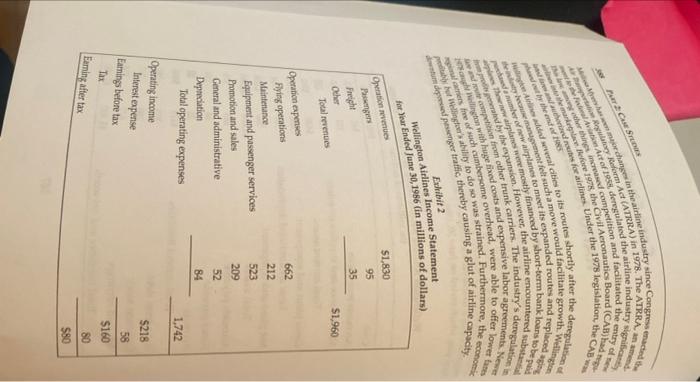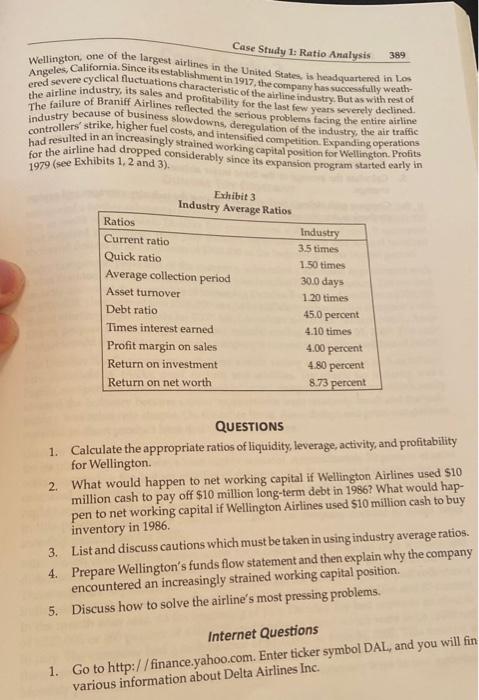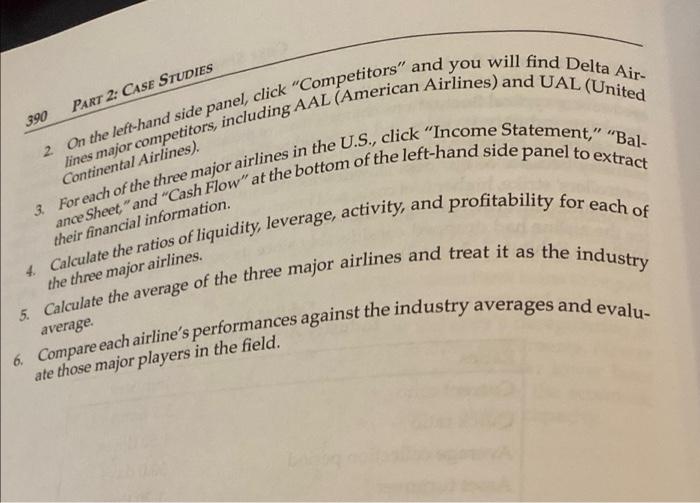Answered step by step
Verified Expert Solution
Question
1 Approved Answer
Answer all questions please, thank you! Case Study 1 RATIO ANALYSIS WELLINGTON AIRLINES Melissa Myers is the new treasurer of Wellington Airlines. She graduated from
Answer all questions please, thank you! 



Case Study 1 RATIO ANALYSIS WELLINGTON AIRLINES Melissa Myers is the new treasurer of Wellington Airlines. She graduated from a major university in Delaware with a M.B.A. in Finance. After five years of experience with one of the "big eight CPA firms in New York, she joined the accounting staff of Midwest assumed the position of treasurer at Wellington Airlines on May 3, 1986. One of her first Airlines and served in a variety of accounting and finance positions for ten years. She responsibilities is to analyze the company's financial condition shortly after the airline's fiscal year, which ended on June 30, 1986, Exhibit 1 Wellington Airlines Balance Sheets as of June 30, 1985-1986 (in millions of dollars) 1985 $42 182 196 S420 1,680 700 1986 $42 140 210 $392 2,072 784 980 $1,400 1.288 $1,680 Cash Accounts receivable Maintenance and supplies inventory Total current assets Gross plant and equipment Less: accumulated depreciation Net plant and equipment Total assets Accounts payable Notes payable Accruals Total current liabilities Long-term debt Common stock Retained earnings Total liabilities and net worth $63 $76 84 280 28 $175 273 50 $406 280 280 280 672 $1,400 714 $1,680 POS dhe mere chin the airline industry since Congress enacted the y form Act (ATRRA) in 1978. The ATRRA, Act of derulated the airline industry slicant hrnce competition and facilitated the entry of was foraires Under the 1978 legislation, the CAB man Bukove the Civil Aeronautics Board (CAB) had del cibles to its routes shortly after the deregulation ement such a move would facilitate growth. Wellington what were mostly financed by short-term bank loans to be paid damer warplans to meet its expanded routes and replaced Non with huge fixed costs and expensive labor agreements New od by the expansion. However, the airline encountered substa ac from other trunk carriers. The industry's deregulation mense of such cumbersome overhead, were able to offer lower les dipenger trattic thereby causing a glut of airline capacity urlington's bity to do so was strained. Furthermore, the economic Edhibit 2 Wellington Airlines Income Statement for Sinar Ended June 30, 1956 (in millions of dollars) Operations $1,830 95 35 Pages Freight Other Total revenues $1,960 Operation expenses Flying operations Maintenance Equipment and passenger services Promotion and sales 662 212 523 209 52 General and administrative Depreciation Total operating expenses 84 1,742 Operating income Interest expense Earnings before tax $218 58 $160 80 Tax Earning after tax $80 389 Case Study 1: Ratio Analysis Wellington, one of the largest airlines in the United States, is headquartered in Los Angeles, California. Since its establishment in 1917, the company has successfully weath- the airline industry, its sales and profitability for the last few years severely declined. ered severe cyclical fluctuations characteristic of the airline industry. But as with rest of The failure of Braniff Airlines reflected the serious problems facing the entire airline industry because of business slowdowns, deregulation of the industry, the air traffic controllers' strike, higher fuel costs, and intensified competition. Expanding operations had resulted in an increasingly strained working capital position for Wellington. Profits for the airline had dropped considerably since its expansion program started early in 1979 (see Exhibits 1, 2 and 3). Exhibit 3 Industry Average Ratios Ratios Current ratio Quick ratio Average collection period Asset turnover Debt ratio Times interest earned Profit margin on sales Return on investment Return on net worth Industry 3.5 times 1.50 times 30.0 days 1.20 times 45.0 percent 4.10 times 4.00 percent 4.80 percent 8.73 percent QUESTIONS 1. Calculate the appropriate ratios of liquidity leverage, activity, and profitability for Wellington 2. What would happen to net working capital if Wellington Airlines used $10 million cash to pay off $10 million long-term debt in 1986? What would hap- pen to net working capital if Wellington Airlines used $10 million cash to buy inventory in 1986. 3. List and discuss cautions which must be taken in using industry average ratios. 4. Prepare Wellington's funds flow statement and then explain why the company encountered an increasingly strained working capital position 5. Discuss how to solve the airline's most pressing problems. Internet Questions 1. Go to http://finance.yahoo.com. Enter ticker symbol DAL, and you will fin various information about Delta Airlines Inc. PART 2: CASE STUDIES 390 Continental Airlines). 2. On the left-hand side panel, click "Competitors" and you will find Delta Air- lines major competitors, including AAL (American Airlines) and UAL (United 3 For each of the three major airlines in the U.S., click "Income Statement," "Bal- ance Sheet" and "Cash Flow"at the bottom of the left-hand side panel to extract 4. Calculate the ratios of liquidity, leverage, activity, and profitability for each of 5. Calculate the average of the three major airlines and treat it as the industry average 6. Compare each airline's performances against the industry averages and evalu- ate those major players in the field. their financial information. the three major airlines 



Step by Step Solution
There are 3 Steps involved in it
Step: 1

Get Instant Access to Expert-Tailored Solutions
See step-by-step solutions with expert insights and AI powered tools for academic success
Step: 2

Step: 3

Ace Your Homework with AI
Get the answers you need in no time with our AI-driven, step-by-step assistance
Get Started


